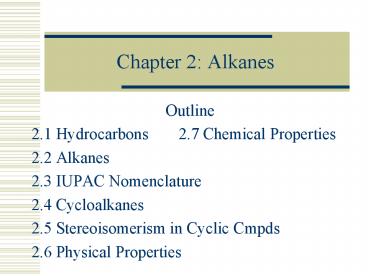Chapter 2: Alkanes - PowerPoint PPT Presentation
1 / 25
Title:
Chapter 2: Alkanes
Description:
Hydrocarbons are compounds which contain only carbon and hydrogen. ... Are colorless, odorless, and tasteless. Physical Properties (Cont'd) ... – PowerPoint PPT presentation
Number of Views:144
Avg rating:3.0/5.0
Title: Chapter 2: Alkanes
1
Chapter 2 Alkanes
- Outline
- 2.1 Hydrocarbons 2.7 Chemical Properties
- 2.2 Alkanes
- 2.3 IUPAC Nomenclature
- 2.4 Cycloalkanes
- 2.5 Stereoisomerism in Cyclic Cmpds
- 2.6 Physical Properties
2
Hydrocarbons
- Hydrocarbons are compounds which contain only
carbon and hydrogen. - a. alkanes only single bonds
- b. alkenes have carbon-carbon double bonds
- c. alkynes have carbon-carbon triple bonds
3
Alkanes
- Alkanes are hydrocarbons with only single bonds
also called saturated hydrocarbons. - e.g. Methane Ethane Propane
- Draw structural formulas and condensed structural
formulas.
4
Alkanes (Contd)
- Table 2.1 Molecular and Structural formulas for
the first 10 alkanes. - Alkanes that are a continuous chain (no
branching) are referred to as n-alkanes. - Branched alkanes are also possible.
- e.g. Isobutane vs butane
5
Alkanes (Contd)
- Types of Carbon
- a. quatenary bonds to four other carbons
- b. tertiary bonded to three other carbons
- c. secondary bonded to two other carbons
- d. primary bonded to one other carbon
6
Alkanes (Contd)
- N-alkanes only have 1 and 2 carbons while
branched alkanes have at least one 3 or 4
carbon. - Isomers for pentane and hexane (show on board).
- Free rotation around bonds.
7
IUPAC Nomenclature of Alkanes and Alkylhalides
- IUPAC (International Union of Pure and Applied
Chemistry) - IUPAC names and common name
- Basis of IUPAC system
- group
- e.g. methyl group from methane
- alkyl groups
8
Rules for Naming Alkanes
- I. Find the longest continuous chain of carbon
atoms. Assign a parent name from Table 2.1. - e.g. Longest chain is 5 carbons, parent name is
pentane. - II. Find whatever groups are not part of the
longest continuous chain and name them as
prefixes (substituents). - e.g. methylpentane
9
Rules (Contd)
- III. Assign numbers to groups by counting from
one end of the chain. Start from the end that
gives the lowest possible numbers to the groups. - IV. If there are two or more of the same group,
use the following prefixes - 2 di- 5 penta-
- 3 tri- 6 hexa-
- 4 tetra-
10
Rules (Contd)
- V. If there are two or more different groups, we
put all of them into the prefix in alphabetical
order. - VI. The four halogens are named by the following
prefixes - F fluoro-
- Cl chloro-
- Br bromo-
- I iodo-
11
Branched Alkyl Groups
- isopropyl secondary
- isobutyl primary
- sec-butyl secondary
- tert-butyl tertiary
- neopentyl primary
12
Cycloalkanes
- Carbon atoms can be connected to each other to
form rings. These are called cycloalkanes. - The most common rings are 4, 5, and 6-membered
rings.
13
Rules for Naming Cycloalkanes
- VII. We may begin at any position and proceed
either clockwise or counterclockwise, but we must
end up with the lowest possible numbers.
14
Examples of Naming Cyclic Alkanes
15
Stereoisomerism in Cyclic Compounds
- In acyclic compounds, there is free rotation
about all the carbon-carbon bonds. - In cyclic compounds, this free rotation does not
exist because the ring prevents it. The result
is a new kind of isomer. - These types of isomers have the same chemical
formula and the same structural formula.
16
Stereoisomers (Contd)
- To test, try to superimpose the two molecules on
top of each other. If they superimpose, the
molecules if not they are different and are
called stereoisomers. - Compounds that have the same structural formulas
but different three-dimensional shapes (cannot be
superimposed) are called stereoisomers.
17
Stereoisomers (Contd)
- Example 1,2-Dimethylcyclopentane
- We use the prefixes cis- and trans- to tell the
two molecules apart. - Cis and trans isomers are found in all rings.
All that is required is that two groups, the same
or different, be substituted for hydrogens. - Since cis and trans are different compounds, the
have different physical and chemical properties.
18
Physical Properties of Alkanes
- Physical State the melting point and boiling
points increase as the molecular weight
increases. - Alkanes and cycloalkanes up to 5 carbons are
gases at room temp. From 5-17 carbons are
liquids and above 17 carbons are white, waxy
solids. Are colorless, odorless, and tasteless.
19
Physical Properties (Contd)
- Solubility Alkanes are nonpolar, therefore,
they are not soluble in water. - Density While alkanes have slightly different
densities, they are all less dense than water.
20
Chemical Properties
- Combustion Alkanes burn in the presence of
oxygen to form carbon dioxide and water (complete
combustion) incomplete combustion gives carbon
monoxide and soot. - C3H8 5O2 ? 3CO2 4H2O heat
21
Chlorination
- Alkanes react with chlorine in the presence of
light to produce chlorinated alkanes. - CH4 Cl2 ? CH3Cl CH2Cl2 CHCl3
CCl4 - This type of reaction is called a substitution
reaction.
22
Reactivity of Alkanes
- Combustion and chlorination are the only reaction
alkanes undergo alkanes are generally chemically
inert.
23
Functional Groups
- A functional group refers to an atom or groups of
atoms that substitutes for a hydrogen atom. - e.g. In alcohols, the functional group is a
hydroxy group OH. - CH3-CH2-OH
- The general formula for alcohols is R-OH, where R
represents any alkyl group.
24
(No Transcript)
25
Important Functional Groups































